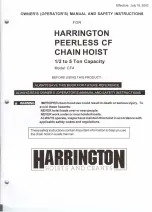
© 2018 Columbus McKinnon Corporation. All Rights Reserved
11
P/N: EL-680 REV AA JULY 2018
WHEEL ASSEMBLY
INSTALLATION
The hoisting unit is custom sized at the factory to fit on
a specific beam size. Most units are slipped over the
end of the supporting rail or beam; however,
removable wheels* are provided which enables the
unit to be fitted on a beam with obstructed ends.
See parts breakdown in Figure 4 for additional
Information regarding disassembly.
The distance between trolley wheel flanges (measured
at the tread diameter) should be 1/8” to 3/16” greater
than the beam flange width for proper running
clearance. This clearance should be checked before
operating the hoist under load. The hoist should be
traversed the entire length of the beam to check for
beam interference pointe, proper side clearance and
effectiveness of the beam stops. If everything is
satisfactory, the procedure should be repeated with a
capacity load as a functional Installation test.
WARNING:
Always make sure all end stops are securely in place
before operating a hoist on a runway beam to prevent
the hoist from falling from the open beam end.
*Feature not available on unit’s operating on patented
monorail tracks.
FIGURE 4: WHEEL ASSEMBLY
WARNING:
Before installing this trolley hoist, make certain that the trolley wheel contour is correct for the type of beam the unit
will operate on and that the trolley wheel spacing is correct for the beam flange width. Flat flange beams should
have flat tread or universal tread wheels and tapered flange beams should have tapered or universal tread wheels.
Used with 1 ½ and 2 ton cap































